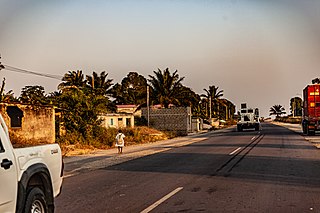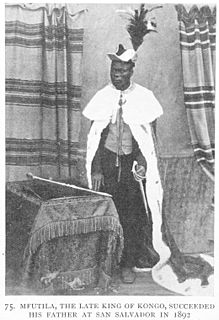Succession
He was the son of a sister of his predecessor Henrique II, and the succession was a contested one, which matched him against Alvaro XIII Ndongo. The electors chose Alvaro XIII to rule, but Pedro, who was expelled from the city, sought the assistance of the Portuguese, who had recently occupied Bembe, located to the south of his core domains. In order to obtain this aid, Pedro swore vassalage to Portugal, the first Kongo king ever to do so. With Portuguese assistance, he was able, after a long struggle, to capture São Salvador and drive Alvaro out. [2]
Reign
Once in power, Pedro worked to strengthen his position, first by using the presence of Portuguese priests to arm his closest followers as Knights of the Order of Christ, and to arrange for the burial of several long dead high ranking Kongo. He also managed to re-concentrate population in São Salvador and rebuild the capital.
Pedro benefited from the transformation of Kongo's economy in the mid-nineteenth century, in which the so-called legitimate trade replaced the export slave trade as Kongo's primary foreign trade. Kongo exported peanuts, ivory and other exotic products to European traders, both Portuguese from Luanda in the colony of Angola, and French, Dutch and English merchants who had been based at Boma, on the Congo River. Pedro managed to win the loyalty of the petty local rulers who controlled that route, and they accepted knighthoods in exchange. He then welcomed factors of the various houses to the capital of São Salvador. [3]
However the new trade links which helped Pedro to gain financial stability and make São Salvador a major commercial center also had its cost. The transformation of the Kongo economy, in common with that of other parts of Central Africa, was in the grips of a "trade revolution" which often put formerly weak local rulers in powerful positions. Pedro faced a major challenge on this front from Garcia Bwaka Matu, whose town of Makuta to the east of São Salvador had become an important trading hub. Bwaka Matu controlled trade and often denied Pedro access to lucrative markets and posed a serious threat from the early 1870s until Bwaka Matu's death in 1881. [4]
Although Pedro had been placed in power by the Portuguese and had accepted vassalage and they in turn had left a garrison in São Salvador, in 1870 the Portuguese decided to withdraw from São Salvador, leaving Pedro in full command. Pedro had already proven to be a problematic vassal, for in the 1860s he had supported rulers in the Dembo area (along the Angolan border) who opposed Portugal. [5]
He was succeeded by his son Alvaro XIV Água Rosada

Battle of Mbwila was a battle that occurred on 29 October 1665 in which Portuguese forces defeated the forces of the Kingdom of Kongo and decapitated king António I of Kongo, also called Nvita a Nkanga.

Álvaro I Nimi a Lukeni lua Mvemba was a Manikongo, or king of Kongo, from 1568 to 1587 and the founder of the Kwilu dynasty.

The Kingdom of Kongo was a kingdom located in central Africa in present-day northern Angola, the western portion of the Democratic Republic of the Congo, the Republic of the Congo as well as the southernmost part of Gabon. At its greatest extent it reached from the Atlantic Ocean in the west to the Kwango River in the east, and from the Congo River in the north to the Kwanza River in the south. The kingdom consisted of several core provinces ruled by the Manikongo, the Portuguese version of the Kongo title Mwene Kongo, meaning "lord or ruler of the Kongo kingdom", but its sphere of influence extended to neighbouring kingdoms, such as Ngoyo, Kakongo, Loango, Ndongo and Matamba, the latter two located in what is Angola today.

Soyo is a city, with a population of 200,920, and a municipality, with a population of 227,175, located in the province of Zaire in Angola, at the mouth of the Congo river. Soyo recently became the largest oil-producing region in the country, with an estimate of 1,200,000 barrels per day (190,000 m3/d).

Garcia II Nkanga a Lukeni a Nzenze a Ntumba, also known as Garcia Afonso for short, ruled the Kingdom of Kongo from 23 January 1641 to 1661. He is sometimes considered Kongo's greatest king for his religious piety and his near expulsion of the Portuguese from Angola. Yet, he is also notorious for enriching himself through his leading role in the Atlantic slave trade.

Álvaro II Nimi a Nkanga was king of Kongo from 1587 to 1614. He was one of Kongo's most powerful and important kings, who succeeded his father Álvaro I, but not until resolving a dispute with his brother. Both sides brought armies to São Salvador but to avoid bloodshed they agreed to single combat, won by Álvaro.

The Kinlaza were members of the Nlaza kanda or House of Kinlaza, one of the ruling houses of the Kingdom of Kongo during the 17th century. It was one of the main factions during the Kongo Civil War along with the Kimpanzu and Kinkanga a Mvika kandas. They are remembered in tradition and are evoked in a proverb, still current in the 1920s Nkutama a mvila za makanda "Kinkanga, Kimpanzu ye Kinlaza makukwa matatu malambila Kongo".
The Battle of Kitombo was a military engagement between forces of the BaKongo state of Soyo, formerly a province of the Kingdom of Kongo, and the Portuguese colony of Angola on 18 October 1670. Earlier in the year a Portuguese expeditionary force had invaded Soyo with the intention of ending its independent existence. The Soyo were supported by the Kingdom of Ngoyo, which provided men and equipment, and by the Dutch, who provide guns, light cannon and ammunition. The combined Soyo-Ngoyo force was led by Estêvão Da Silva, and the Portuguese by João Soares de Almeida. Both commanders were killed in the battle, which resulted in a decisive victory for Soyo. Few, if any, of the invaders escaped death or capture.
The precolonial history of Angola lasted until Portugal annexed the territory as a colony in 1655.
The colonial history of Angola is usually considered to run from the appearance of the Portuguese under Diogo Cão in 1482 (Congo) or 1484 until the independence of Angola in November 1975. Settlement did not begin until Novais's establishment of São Paulo de Loanda (Luanda) in 1575, however, and the Portuguese government only formally incorporated Angola as a colony in 1655 or on May 12, 1886.
The Kongo Civil War (1665–1709) was an internal conflict between rival houses of the Kingdom of Kongo. The war waged throughout the middle of the 17th and 18th centuries pitting partisans of the House of Kinlaza against the House of Kimpanzu. Numerous other factions entered the fray claiming descent from one or both of the main parties such as the Água Rosada of Kibangu and the da Silva of Soyo. By the end of the war, Kongo's vaunted capital had been destroyed and many Bakongo were sold into the Trans-Atlantic Slave Trade.

Água Rosada or Álvaro XIV was ruler in Kongo, Africa, from February 1891 to 1896. His father signed the vassalage of Kongo in 1888.
The Portuguese colony of Angola was founded in 1575 with the arrival of Paulo Dias de Novais with a hundred families of colonists and four hundred soldiers. Luanda was granted the status of city in 1605. The fortified Portuguese towns of Luanda and Benguela.
Alvaro VIII, of the House of Kinlaza, was king of the Kingdom of Congo, from 1666 to 1669.

Mbanza-Kongo, is the capital of Angola's northwestern Zaire Province with a population of 148,000 (2014). Mbanza Kongo was founded some time before the arrival of the Portuguese in 1483 and was the capital of the Kilukeni dynasty ruling at that time. The site was temporarily abandoned during civil wars in the 17th century. It lies close to Angola's border with the Democratic Republic of the Congo. It is located at around 6°16′0″S14°15′0″E and sits on top of an impressive flat-topped mountain, sometimes called Mongo a Kaila because recent legends recall that the king created the clans of the kingdom and sent them out from there. In the valley to the south runs the Luezi River. In 2017, Mbanza Kongo was declared as a UNESCO World Heritage Site.
Rafael I Nzinga a Nkanga was a ruler of the Kingdom of Kongo during its civil war. He ruled from 1670 to 1673.
Daniel I Miala mia Nzimbwila was a ruler of the Kingdom of Kongo during its civil war between the various royal houses. He ruled from 1674 to 1678.
Henrique III Mpanzu a Nsindi a Nimi a Lukeni was ruler of the Kingdom of Kongo from the Kivuzi branch of the Kinlaza house, who reigned from 1840 until 1857. Henrique came to power when he overthrew his predecessor, André II. This was with the support of the elector Ntinu Nsaku. Henrique did not manage to kill Andre II and King Andre continued to exercise power from Mbanza Maputu over some of the Kongo realm.
Alvaro XIII or Ndongo was king of Kongo from 1857 until 1859. He was a member of the Nkanga branch of the Kimpanzu house.









